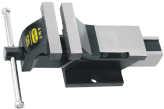If you are reading this blog, you may be looking to buy a bench vice and due to this fact, you may want to know different parts of bench vice and their functions. They can be used to secure workpieces or hold things to perform tasks on the workpieces. The bench vices are simple to use as simple as twisting/turning the handle.
Table of Contents
ToggleWhy is a Bench Vice Important Device in a Workshop?
The bench vice is an essential device used in a workshop. It is one of the most used tools by workshop owners and handymen. Whether you work on wood or metal, you can use a vice clamp. It is one of the best tools that can be used to secure the object while performing different operations on that object. Professionals and experienced workers know how to use bench vice. However, for beginners, it might be a new experience as they are having their first interaction with a vice.
Bench Vise Parts and Functions
Now, from the below section, you’ll come to know about bench vice parts names along with their functions:
- The Base
The base of the bench vice is the foundation that holds everything together. The base of the bench vice is tightened with the bench and it comes in a variety of designs. Some bench vices come with a 360 degrees swivel base and some come with a fixed base. It is up to you what type of bench vice you want for your DIY projects or workshop.
- The Jaw
Jaws or vice clamps are used to secure workpieces of different sizes. One jaw is fixed and another one is moveable. They can be tightened or loosened as per the object’s requirements- Sliding jaw: The sliding jaw is moved when the handle is turned. It applies force on the object that is being clamped. If you are using it for the first time, then it may not seem difficult to you. It is the part of the vice that enables motions and has a handle.
- Static jaw: As the name implies, it is a fixed jaw. The sliding jaw applies pressure for its immovability.
- The Slide
The part moves when you turn the handle of the vice. It applies force to the object. It is connected to the sliding jaw.
- Handle
One of the most sophisticated parts of the bench vices is its handle. The lever is attached to the handle. When turning the handle, make sure not to overtighten it. The vice can be damaged, this is what happens if the vice handle is over tightened. The pressure applied to turn the handle multiplies and while clamping, if you notice that object being bent, then stop and reverse the handle
- The Anvil
The anvil comes in handy form and it is useful when you need to give shape to objects. You can use it as a base for your hammer nails.
- Serrated Jaws
Serrated jaws are considered the actual point where the vise meets with an object you are fastening. Serrated jaws can damage the object when tightened too much. Don’t apply too much pressure as you may end up damaging the object you worked on. Moreover, if the object is not destroyed, then it might be possible that it ends up with scratches or cracks. If you want to avoid this mess, then it is recommended to apply the pressure that is required.
How to Buy a Bench Vice?
Sometimes, buying the best bench vice can get challenging. Here are a few things that you should consider when buying a bench vice:
- Make sure to check the throat depth of the vice from the top of its jaws to the bottom of the jaws.
- The next thing that you need to consider is the weight of the bench vise. The weight of the vise may differ even though the jaw width of the two vices may be the same.
- Determine how you are going to use the vice. In case, if the hammering is involved, then you can buy a vice with a large rear anvil.
Conclusion
The blog shares bench vise parts and functions along with tips when buying a bench vise. If you are looking to buy high-quality bench vice for your workshop, you can contact Ajay Tools.


